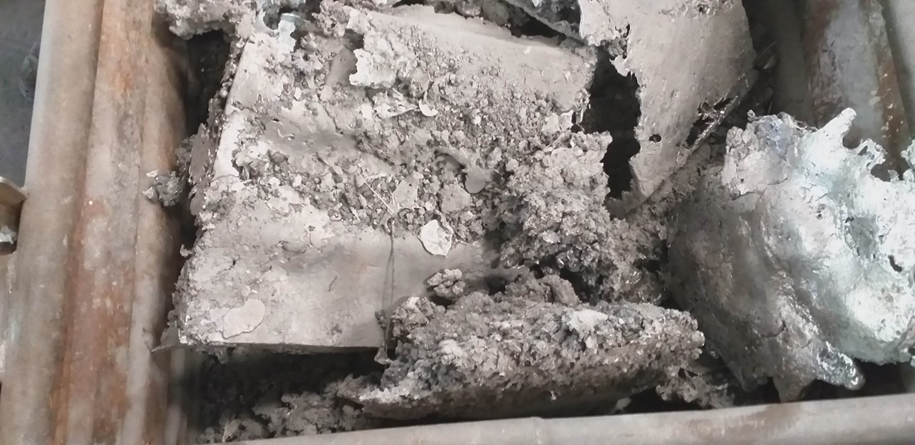Editor's Note: The following is the first of several technical articles that have been developed by Mr. Fernando Oliveria, also known as Dr. Foundry, on behalf of our NFFS membership. Look for future technical articles in The Crucible newsletter. Have a question you would like answered by Dr. Foundry? Send your question to info@nffs.org and see the response in a future Dr. Foundry technical article!
Slagging is a crucial step in the aluminum casting process. It involves the formation of an insulating layer, typically composed of aluminum oxide, on the surface of the molten metal. This slag layer protects the aluminum against oxidation, improves the quality of the final product, and ensures process efficiency. In this tutorial, we will explore the correct process of slagging aluminum liquid, highlighting the steps and recommended practices.

*Rich aluminum slag skimmed from furnace
Equipment and Material Preparation: Before commencing the slagging process, it is essential to ensure that the equipment and material are ready. Verify that the slag being used is suitable for aluminum liquid and free from contaminants. Prepare the slag in appropriate quantities, considering the amount of molten metal to be slagged. Ensure you have an efficient slag collection system, such as proper slagging equipment or a furnace with integrated slagging.
Cleaning the Molten Metal: Prior to slagging the aluminum liquid, it is necessary to remove any impurities or contaminants from the metal's surface. Use a suitable cleaning agent to remove oxides, greases, or other residues present on the surface. Proper cleaning helps promote adequate adhesion of the slag. Dr. Foundry recommends using 0.1% to 0.3% slag flux over the total amount of metal to be treated. The ideal amount is presented by the supplier in its technical brochures.
Addition of Slag: With the clean molten metal, proceed to add the slag gradually and in a controlled manner. Spread the slag evenly over the metal's surface, ensuring that all areas are covered. Avoid adding an excessive amount of slag as this can negatively impact the casting process performance.
Distribution of Slag: After adding the slag, it is important to ensure proper distribution across the molten metal's surface. This can be achieved through gentle agitation using appropriate tools such as a slagging rod. The goal is to ensure that the slag spreads uniformly, covering the entire metal surface and forming a homogeneous protective layer.
Maintenance of the Slag Layer: Once the slag layer is formed, it is crucial to avoid excessive disturbances on the metal surface, such as vigorous agitation, which can break the slag layer. Additionally, regularly monitor the slag thickness and make necessary adjustments by adding more slag if required.
Slag Removal: At the end of the cleaning process, it is necessary to remove the slag before pouring the molten metal into molds or containers. Various techniques can be employed for slag removal, such as mechanical slagging or the use of appropriate tools to "sweep" the slag into a separate container. Careful slag removal is essential to ensure the quality of the cast aluminum.
Proper Slag Disposal: After slag removal, it is important to properly dispose of the material. Aluminum slag can contain impurities and harmful substances, so it is advisable to follow local environmental regulations and guidelines for safe disposal. Contact competent authorities or waste treatment companies for guidance on appropriate slag disposal methods.
Provided below is a video demonstrating the proper process for slagging liquid aluminum:
Proper slagging of aluminum liquid plays a vital role in obtaining high-quality end products in casting. By following the recommended steps and practices outlined in this tutorial, you will be able to perform the slagging process efficiently and ensure adequate protection of aluminum against oxidation. Always remember to adhere to safety standards and environmental regulations throughout the process. With practice and attention to detail, you will be well on your way to achieving consistent, high-quality results in aluminum casting.
 Dr. Fernando Oliveira (Dr. Foundry) is a foundry specialist with more than 20 years of experience in the foundry process and application of products for metallurgical treatment. He is CEO of Doutor Fundição Sociedade Técnica de Fundidores in Brazil and can be reached at fernando@doutorfundicao.com.br.
Dr. Fernando Oliveira (Dr. Foundry) is a foundry specialist with more than 20 years of experience in the foundry process and application of products for metallurgical treatment. He is CEO of Doutor Fundição Sociedade Técnica de Fundidores in Brazil and can be reached at fernando@doutorfundicao.com.br.
